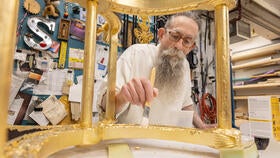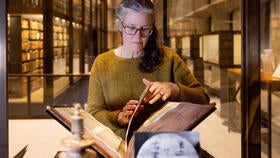
Caring for a collection the size of the Yale Library system, with 15 million books and countless objects, may seem an overwhelming task. Yet the staff at the Library Center for Preservation and Conservation deftly take on this mission one item at a time.
On a recent afternoon at the sprawling center at 344 Winchester Avenue, Preventive Conservation Technician Dong Dong and Conservation Housing Technician Meagan Timmins were working to preserve fragile and unusual large and small books and objects. They specialize in creating housings in the form of sturdy, made-to-fit boxes used to conserve all types of treasures. These enclosures help mitigate the effects of time and use while providing safe access for future study.
Inside their workroom is a queue of items, including musical instruments, textiles, ceramics, small eighteenth-century children’s books, and large fifteenth-century ecclesiastical books, to name just a few. Their tools of the trade include micro spatulas, knives, brushes, measuring devices, and one large box-making machine—the Kasemake Mini Grand PRO. Nicknamed the “Minnie,” it quickly cuts and creases corrugated boxboard, foam board, and other materials, creating custom-made archival boxes of varying sizes and shapes.
 The box-making machine nicknamed “Minnie” smoothly plots, cuts, and creases the gray and white corrugated boxboard.
The box-making machine nicknamed “Minnie” smoothly plots, cuts, and creases the gray and white corrugated boxboard.
Getting Started
Dong and Timmins patiently inspect each object for any damage, determine its composition, research its history, and consider its shape and size. Then, they carefully record its dimensions using a tape measure or a book-measuring device as they devise the optimal housing. Satisfied with their calculations, they feed the item’s dimensions or specific information into Minnie’s software, which turns that data into a custom-designed enclosure.
 The Minnie’s design screen shows a drawing of a deconstructed clamshell box.
The Minnie’s design screen shows a drawing of a deconstructed clamshell box.
“When studying each item, we decide the best way to support it while allowing easy access for researchers or anyone who wants to see it,” said Dong.
Preserving a nineteenth-century game box and its contents
This past winter Dong and Timmins collaborated to develop housing for an early nineteenth-century game box made of wood and bone. The decorative case contained a deck of cards, a game of dominos, and a spinning top called a teetotum used for gambling. The handmade and hand-painted cards and dominos were tiny, measuring about 17 mm x 30 mm (.70 inches X 1.18 inches) each.
 The 200-year-old set is missing a few pieces: the 3/3, 5/9, and 8/9 dominoes.
The 200-year-old set is missing a few pieces: the 3/3, 5/9, and 8/9 dominoes.
“We believe this set is from England and dates sometime between 1802 and 1814. It is one of many types of boxes made by French sailors captured and imprisoned by the British Navy during the Napoleonic Wars. The materials used to create these tiny game pieces were probably discarded animal bones and the dyes used on the playing cards were most likely derived from vegetables,” said Timmins, conservation housing technician.
 The materials used to create these tiny game pieces were probably discarded animal bones. The dyes used on the playing cards were most likely derived from vegetables.
The materials used to create these tiny game pieces were probably discarded animal bones. The dyes used on the playing cards were most likely derived from vegetables.
Given the size and number of items in this set, it took a fair amount of brainstorming and prototyping before Dong and Timmins came up with the best option to safely enclose all these toy-sized game pieces while still allowing for ease of viewing.
“We had hoped to keep everything in the original case, but bone is very susceptible to moisture. Ultimately, we wanted to protect the set from any environmental issues but also make it accessible. Now, all these items can be seen and studied with minimal handling,” said Dong.
 Timmins removes the large, perforated sheet and pops out the flat form, deftly bending and folding to produce a drop spine (clamshell) style box.
Timmins removes the large, perforated sheet and pops out the flat form, deftly bending and folding to produce a drop spine (clamshell) style box.
To create the optimal enclosure, Dong and Timmins carefully measured each card and domino, which are all slightly different sizes. They then mapped out how the pieces would be displayed on in the Kasemake Software and fed that data into Minnie, which made intricate cuts to the foam material. Once the cutting was complete, they assembled the outer box and gently added the game pieces to the foam board.
 The game set is now housed at the Beinecke Rare Book and Manuscript Library.
The game set is now housed at the Beinecke Rare Book and Manuscript Library.
“It’s a miracle that this set has stayed together for over 200 years. However, it is missing a few pieces— the King of Clubs, Queen of Hearts, and the 3/3, 5/9, and 8/9 dominoes,” said Timmins.
 To create the optimal enclosure, Dong and Timmins carefully measured each card and domino, which are all slightly different sizes. Then they mapped out how the pieces would be displayed on the whiteboard.
To create the optimal enclosure, Dong and Timmins carefully measured each card and domino, which are all slightly different sizes. Then they mapped out how the pieces would be displayed on the whiteboard.
Fun and Challenging work
Dong and Timmins relish the many facets of this hands-on work and their close contact with such a diverse variety of cultural heritage artifacts. Many of the pieces they work on go back to the libraries or the Library Shelving Facility. The game set is now housed at the Beinecke Rare Book and Manuscript Library.
“Most people are surprised to learn that the majority of what we work on are not books but all types of objects,” said Timmins.
 Dong reviewing a 600-year-old, hand-printed book before placing it in its new box enclosure.
Dong reviewing a 600-year-old, hand-printed book before placing it in its new box enclosure.
“What is the most fun and challenging at the same time is that every object is different. We learn about its history and get to design something specific for each piece. Sometimes these items or books need protection from light, touch, or moisture, so a lot of different considerations go into creating the perfect enclosures to keep them safe for future generations to view, study, and enjoy,” said Dong.






